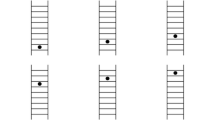Abstract
The Congruence Scale derives from the construct of congruence, the goal of therapeutic change in the Satir model. Congruence is conceptualized as a state of awareness, openness, and connection in three human dimensions: the Intrapsychic, Interpersonal, and Universal-Spiritual. Procedures in developing the Congruence Scale are described. Results provide evidence of concurrent validity with the Satisfaction With Life Scale and the Outcome Questionnaire. Four factors of the Congruence Scale are extracted from factor analysis: Intrapsychic-Interpersonal, Spiritual, Creative, and Communal. Further research to confirm the reliability and validity of the congruent construct is recommended.
Similar content being viewed by others
REFERENCES
Alexander, J. F., Holtzworth-Munroe, A., & Jameson, P. B. (1994). The process and outcome ofmarital and family therapy: Research, review and evaluation. In A. E. Bergin & S. L. Garfield (Eds.), Handbook of pychotherapy and bhavior change (pp. 595–630). New York: Wiley and Sons.
Banmen, A., & Banmen, J. (Eds.). (1991). Meditations of Virginia Satir. Palo Alto: Science and Behavior Books.
Becvar, D., & Becvar, R. (1996). Family therapy: A systemic integration. Toronto: Allyn and Bacon.
Davis, B., McLendon, J., Freeman, M., Hill, N., Loberg, J., Lester, T. & Huber, C. (1996). Satir and congruence: A response. In B. J. Brothers (Ed.), Couples and the Tao of congruence (pp. 143–148). New York: Haworth Press.
Diener, E., Emmons, R. A., Larsen, R. J., & Griffin, S. (1985). The satisfaction with life scale. Journal of Personality Assessment, 49, pp71–75.
Duhl, B. (1989). Virginia Satir: In memoriam. Journal of Marital and Family Therapy, 15, 109–110.
Goldenberg, I. & Goldenberg, H. (1996). Family therapy: An overview (4th ed.). Belmont, CA: Brooks/Cole.
Gurman, A. S., Kniskern, D. P., & Pinsof, W. M. (1986). Research on marital and family therapies. In S. L. Garfield & A. E. Bergin (Eds.), Handbook of psychotherapy and behavior change (pp. 565–624). New York: Wiley and Sons.
Lambert, M. J., & Burlingame, G. M. (1996). Outcome questionnaire. NJ: American Professional Credentialing Services LLC.
Lambert, M. J., Okiishi, J. C., Finch, A. E., & Johnson, L.D. (1998). Outcome assessment: From conceptualization to implementation. Professional Psychology, 29, 63–70.
Lee, B. (2002). Congruence in Satir's model: Its spiritual and religious significance. Contemporary Family Therapy, 24(1), pp57–78.
Liddle, H. A. (1991). Empirical values and the culture of family therapy. Journal of Marital and Family Therapy, 17, 227–348.
Loeschen, S. (1998). Systematic training in the skills of Virginia Satir. Pacific Grove, CA: Brooks/Cole.
Nichols, M. P., & Schwartz, R. C. (1998). Family therapy: Concepts and methods (4th ed.). Boston: Allyn and Bacon.
Olson, D. H. (1976). Bridging research, theory, and application: The triple threat in science. In D. Olson (Ed.), Treating relationships (pp. 565–579). Lake Mills, IA: Graphics Press.
Pavot, W., & Diener, E. (1993). Review of the Satisfaction with Life Scale. Psychological Assessment, 5, 164–172.
Satir, V. (1964). Conjoint family therapy. Palo Alto, CA: Science and Behavior Books.
Satir, V. (1986). A partial portrait of a family therapist in process. In C. Fishman & B. Rosman (Eds.), Evolving models for family change (pp. 278–293). New York: Guilford Press.
Satir, V. (1988). The new peoplemaking. Mountain View, CA: Science and Behavior Books.
Satir, V., & Banmen, J. (1983). Virginia Satir verbatim. North Delta, B.C.: Delta Psychological Associates.
Satir, V., Banmen, J., Gerber, J., & Gomori, M. (1991). The Satir model: Family therapy and beyond. Palo Alto, CA: Science and Behavior Books.
Sprenkle, D., Keeney, B., & Sutton, P. (1982). Theorists who influence clinical members of AAMFT: A research note. Journal of Marital and Family Therapy, 8, 367–369.
Sprenkle, D., & Moon, S. (Eds.). (1996). Research methods in family therapy. New York: Guilford Press.
Umphress, V. J., Lambert, M. J., Smart, D. W., Barlow, S. H., & Clouse, G. (1997). Concurrent and construct validity of the Outcome Questionnaire. Journal of Psychoeducational Assessment, 15, 40–55.
Author information
Authors and Affiliations
Rights and permissions
About this article
Cite this article
Lee, B.K. Development of a Congruence Scale Based on the Satir Model. Contemporary Family Therapy 24, 217–239 (2002). https://doi.org/10.1023/A:1014390009534
Issue Date:
DOI: https://doi.org/10.1023/A:1014390009534




